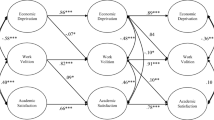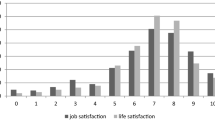Abstract
As one aspect of a study on faculty career development, relationships between work and life away from work were explored for 112 faculty members. The sample, from one department in the humanities and one in the natural sciences and from two professional schools, was stratified by academic rank and sex. The study employed in-depth interviews followed by questionnaires. Results of regression analyses indicated that both aspects of work and life outside of work were related to work satisfaction; likewise, work as well as nonwork conditions were associated with satisfaction in life away from work. Second, work and aspects of life away from work exerted indirect effects on life satisfaction. Finally, and unlike the general population, academics appeared to experience a high degree of “spillover” between work and life away from work.
Similar content being viewed by others
References
Allen, H. M., Jr., Bentler, P. M., and Gutek, B. A. (1985). Probing theories of individual well-being: A comparison of quality-of-life models assessing neighborhood satisfaction.Basic and Applied Social Psychology 6: 181–203.
Andrews, F. A., and Withey, S. B. (1974). Developing measures of perceived life quality.Social Indicators Research 1: 1–26.
Andrews, F. A., and Withey, S. B. (1976).Social Indicators of Well-being in America: The Development and Measurement of Perceptual Indicators. New York: Plenum Press.
Baldwin, T. A., Tate, M., and Youtz, M. A. (1986). Job and life satisfaction: A metaanalytic examination of the strength of the relationship and gender effect. Paper presented at the Midwestern Meeting of the Academy of Management, St. Louis.
Bayer, Alan E. (1973). Teaching faculty in academe: 1972–73. A.C.E. Research Reports, No. 8. Washington, D.C.: American Council on Education.
Campbell, A. (1976). Subjective measures of well-being.American Psychologist 31: 177–223.
Campbell, A. (1981).The Sense of Well-being in America. New York: McGraw-Hill.
Campbell, A., Converse, P. E., and Rogers, W. L. (1976).The Quality of American Life: Perceptions, Evaluations, and Satisfaction. New York: Sage Foundation.
Carnegie Foundation for the Advancement of Teaching. (1986). The satisfied faculty.Change, March/April, 31–34.
Clark, S., and Lewis, D. R. (Eds.). (1985).Faculty Vitality and Institutional Productivity. New York: Teachers College Press.
Clark, S. M., Corcoran, M., and Lewis, D. R. (1986). The case for an institutional perspective on faculty development.Journal of Higher Education 57(2): 176–194.
Duncan, O. D., (1961). Status of occupations. In A. Reiss, O. D. Duncan, R. Hatt, and C. North (eds.),Occupations and Social Status. New York: Free Press.
Eble, K. E., and McKeachie, W. J. (1985).Improving Undergraduate Education through Faculty Development. San Francisco: Jossey-Bass.
Finkelstein, M. J. (1984).The Academic Profession. Columbus: Ohio State University Press.
Gerystl, J. (1971). Leisure, taste, and occupational milieu. In C. Anderson and J. Murray (eds.),The Professor. Cambridge, Mass.: Schenkman.
Hackman, J. R., and Lawler, E. E. (1971). Employee reactions to job characteristics [Monograph].Journal of Applied Psychology 55: 259–286.
Harry, J., and Goldner, N. S. (1972). Null relationship between teaching and research.Sociology of Education 45: 47–60.
Kabanoff, B. (1980). Work and nonwork: A review of models, methods and findings.Psychological Bulletin 88: 60–77.
Kabanoff, B., and O'Brien, G. E. (1980). Work and leisure: A task attributes analysis.Journal of Applied Psychology 65: 596–609.
Kando, T. M., and Summers, W. C. (1971). The impact of work on leisure: Toward a paradigm and research strategy.Pacific Sociological Review 14: 310–327.
Marx, K., and Engels, F. (1939).The German Ideology. New York: International Publishers.
Mathis, C. (1979). Academic careers and adult development: A nexus for research.Current Issues in Higher Education 2: 21–27.
Meissner, M. (1971). The long arm of the job. In W. E. Mann (ed.),Canada: A Sociological Profile. Toronto: Copp-Clark.
Near, Janet P. (1984). Relationships between job satisfaction and life satisfaction: Test of a causal model.Social Indicators Research 15: 351–367.
Near, J. P., Rice, R. W., and Hunt, R. G. (1980). The relationship between work and nonwork domains: A review of empirical research.Academy of Management Review 5: 415–429.
Near, J. P., Rice, R. W., and Hunt, R. G. (in press). Job satisfaction and life satisfaction: A profile analysis.Social Indicators Research, forthcoming.
Near, J. P., Smith, C. A., Rice, R. W., and Hunt, R. G. (1983). Job satisfaction and nonwork satisfaction as components of life satisfaction.Journal of Applied Social Psychology 13: 126–144.
Near, J. P., Smith, C. A., Rice, R. W., and Hunt, R. G. (1984). A comparison of work and nonwork predictors of life satisfaction.Academy of Management Journal 27: 184–190.
Orpen, C. (1978). Work and nonwork satisfaction: A causal correlational analysis.Journal of Applied Psychology 63: 530–532.
Pedhazur, E. J. (1982).Multiple Regression in Behavioral Research (2nd ed.). New York: Holt, Rinehart and Winston.
Quinn, R. P., and Shepard, L. J. (1974).The 1972–73 Quality of Employment Study. Ann Arbor: Institute for Social Research, University of Michigan.
Rice, R. W., McFarlin, D. B., Hunt, R. G., and Near, J. P. (1985). Organizational work and the perceived quality of life: Toward a conceptual model.Academy of Management Review 26: 177–188.
Rice, R. W., McFarlin, D. B., Hunt, R. G., and Near, J. P. (in press). Moderators of the relationship between job satisfaction and life satisfaction.Basic and Applied Social Psychology, forthcoming.
Rice, R. W., Near, J. P., and Hunt, R. G. (1979). Unique variance in job and life satisfaction associated with work-related and extra-workplace variables.Human Relations 32: 605–623.
Rice, R. W., Near, J. P., and Hunt, R. G. (1980). The job satisfaction-life satisfaction relationship: A review of empirical research.Basic and Applied Social Psychology 1: 37–64.
Sarason, S. B. (1977).Work, Aging and Social Change: Professionals and the One Life-One Career Imperative. New York: Free Press.
Schmitt, N., and Bedeian, A. G. (1982). A comparison of LISREL and two-stage least squares analysis of hypothesized life-job satisfaction reciprocal relationship.Journal of Applied Psychology 67: 806–817.
Schmitt, N., and Mellon, P. M. (1980). Life and job satisfaction: Is the job central?Journal of Vocational Behavior 16: 51–58.
Sorcinelli, M. D. (1985). Faculty careers: Personal, institutional and societal dimensions. Paper presented at the meeting of the American Educational Research Association, Chicago.
Sorcinelli, M. D., and Near, J. P. (1986). Relations between work and life away from work among university faculty: Gender and rank effects. Presented at the Annual Meeting of the American Educational Research Association, San Francisco.
Staines, G. L. (1980). Spillover versus compensation: A review of the literature on the relationship between work and nonwork.Human Relations 33: 111–129.
Wilensky, H. L. (1960). Work, careers, and social integration.International Social Science Journal 12: 543–560.
Wilson, R. C., and Gaff, J. G. (1975).College Professors and Their Impact on Students. New York: Wiley.
Author information
Authors and Affiliations
Rights and permissions
About this article
Cite this article
Near, J.P., Sorcinelli, M.D. Work and life away from work: Predictors of faculty satisfaction. Res High Educ 25, 377–394 (1986). https://doi.org/10.1007/BF00992133
Received:
Issue Date:
DOI: https://doi.org/10.1007/BF00992133




